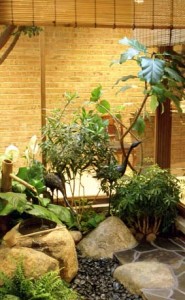Japanese Garden Water Feature, Tsukubai or water basin
 March 6, 2012
March 6, 2012
The “tsukubaiâ€, or water basin, is a common water feature found in Japanese gardens. Before entering a tea room guests were expected to be pure of mind and body. Thus the tea garden provided a serene environment to relax the spirit and within it the garden a water basin for cleansing the body. The water from the basin stone was used by guests to wash their hands. It is also common to use the wooden ladle and spill water onto the stepping stone pathways that lead to entrance of the tea room.
Tuskubai water features are often and intentionally set very low to help induce humility. The low height forces guests to bend down while washing. This is also where the name “tsukubai, comes from, it means “to bend or crouchâ€.
The two key stones of a tsukubai are the water basin stone and the front stone. Water basin stones are set on the edge, or center of the sea stone. The sea stone is the field of smaller stone that the overflowing water will drain through with the drain, or reservoir below. The front stone is a stepping stone intended for the user of the tsukubai to stand on. Additional stones are set using the gogan technique creating the enclosure of the sea stone.
In some cases the over flowing water from a tsukubai water feature simple spills into an adjacent garden stream. Do not place your tsukubai next to a waterfall, if you are consider this option of integrating the tsukubai and pond stream. A stone lantern is often positioned near the tsukubai to create vertical balance. The oribe style lantern is perhaps the most commonly used for this purpose.
In addition to the stonework of the tsukubai Japanese water feature, the source of the water is also important. Bamboo piping is by far most commonly used. Bamboo will typically need to be replaced every couple of years depending on a variety of factors. If you do not want the hassle of replacing the bamboo spout, you could consider using copper piping. Keep in mind that copper is not traditionally used. You can also have fun with artistic detailing of the bamboo spout. The support used for the bamboo spout, the length of the bamboo, how the bamboo ends and where the bamboo ends are all areas which can be aesthetically interesting. Keep in mind that the spout should still be a subtle element and not over power the stonework of the water basin or other garden elements. The spout itself should end over the center of the bowl of the basin stone and should not be any more than 12†above it. I often set it much lower than this, more like 6-8†above the water basin stone.
Lastly, and perhaps the best part is when compared to other quality water feature options Japanese tsukubai is very cost effective and have great value.
If you would like our help with a Japanese Tsukubai water feature please contact us, Niwa Design Studio, at 952-470-1882.

 Posted in
Posted in  content rss
content rss